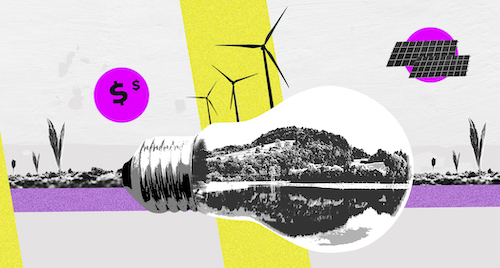
First, we should say none of the ideas we’re breaking down below represent the last word on U-M’s carbon neutrality plan. But the nine analysis teams tasked with putting together policy recommendations for that final plan have offered up some really quality proposals for reaching the net-zero milestone. In the event you don’t have time to dig through the hundreds of pages of analysis yourself, we’ve broken down three ideas we found particularly fascinating. And by the way: The teams are now collecting public comment on all their reports before they head to President Schlissel’s office in February 2021. You can find all nine reports on the U-M President’s Commission on Carbon Neutrality website, and submit your comments via an online form.
Putting a price on carbon
Putting a price on carbon is the cornerstone of many climate change policies. The basic idea is that we need to account for carbon pollution’s detrimental impacts when considering the price of fossil fuel-based energy. When we no longer give carbon emissions a free ride, it turns out fossil fuels aren’t so cheap — which strengthens the business case for energy efficiency projects and adoption of renewables. The Energy Consumption Policies Internal Analysis Team leverages this idea by creating an internal carbon pricing scheme for university operations. Essentially, business units would be charged according to their carbon footprints, and the resulting revenue would fund projects that draw down carbon emissions. Thirty percent of this revenue would be returned directly to the unit for its own energy efficiency initiatives. The remaining share would go into a Revolving Energy Fund (REF), which other campus units could use to finance their own energy conservation measures. Loans from the fund would be repaid through savings generated by REF-funded projects, thereby creating a self-sustaining revenue stream for projects across the university.
The team notes that REFs have been used successfully at other institutions and estimates that adoption of an internal carbon pricing scheme and Revolving Energy Fund would reduce emissions from existing buildings by 25% over 10 years. You can read more about these two policy recommendations in the Energy Consumption Policies Internal Analysis Team’s full report.
Reducing emissions from commuting
Emissions from commuting represent a substantial part of the U-M system’s overall carbon footprint. According to the Mobility Electrification Analysis Team’s report, emissions from personal vehicles used by faculty, staff and students traveling to and from campus are roughly equivalent to 40 percent of the university’s “Scope 1 emissions” — the top-line emissions that come from on-site electricity generation, heating and cooling of buildings, and university-owned vehicles. On the Ann Arbor campus, faculty and staff account for the largest share of vehicle miles traveled, while on the Dearborn campus, students have the bigger carbon footprint.
So how do we reduce emissions from commuting? The Commuting Analysis Team put forward a broad menu of recommendations, many of which disincentivize solo travel in personal vehicles and incentivize other forms of transportation. These include: Replacing the monthly parking fee with a pay-by-the-day model to discourage solo car trips to campus; tying parking fees to ability to pay (e.g. staff salary); expanding Ann Arbor’s vanpool system to the Dearborn campus; contracting with the regional SMART bus system to provide free public transportation for UM-Dearborn faculty, staff and students, similar to Ann Arbor’s “Blue Bus” system; building more on-campus student housing; and providing incentives for faculty and staff to live closer to campus. In addition, the Mobility Electrification Analysis Team recommends greatly expanding campus’ EV charging infrastructure, with the university continuing to cover the cost of electricity. The idea is this would encourage faculty, staff and students to purchase EVs as their personal vehicles.
Interestingly, the Commuting Analysis Team says the jury is still out on what’s often seen as a silver bullet solution: more telecommuting. From the report:
Recent research has suggested that telecommuting may paradoxically increase rather than decrease carbon emissions among telecommuters — a so-called “rebound effect” stemming from three sources: telecommuters’ non-work trips on telecommuting days, telecommuters’ willingness to live farther from work, and telecommuters’ high use of low-carbon transportation modes, which sharply reduces their savings on telecommuting days.
However, the team did note that a small-scale analysis of 14 telecommuting employees at UM-Dearborn and 248 in Ann Arbor did suggest a reduction in vehicle miles traveled. Read more in the Commuting Analysis Team’s full report.
Biosequestration
Get ready to hear a lot more about biosequestration in the coming years. That’s because there’s increasing consensus that climate change mitigation strategies will likely involve both reducing future emissions and pulling past carbon emissions out of the atmosphere. Nature is full of organisms and systems that can help us do this. Trees and forests get the most attention, but they’re not the only options. In places like California, research suggests grasslands are often the optimal ecosystem for sequestering carbon; while in many parts of the Midwest, wetlands offer the most potential.
Given this, the Biosequestration Analysis Team put together three key recommendations. First, U-M should protect in perpetuity more than 7,000 hectares of natural lands it currently owns so they can continue to perform their valuable ecological functions. Second, the university should improve its natural lands, which would notably include converting available agricultural land into wetland. Third, the university should take steps to enhance the carbon-storing capacity of its campus landscapes. This would include planting more trees to increase the canopy on campus; replacing turfgrass; and creating more “green infrastructure,” like rain gardens, native plant gardens, bioswales and green roofs. Given that UM-Dearborn is situated adjacent to the Rouge River, green infrastructure will no doubt be an important strategy for our campus. You can read more about biosequestration strategies in the full report.





